Bertha Chandler (1885-1961)
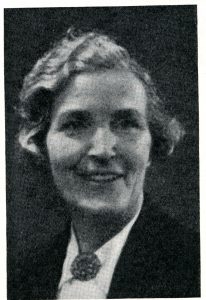
Photograph of Bertha Chandler published in Transactions Royal Scottish Society of Arts, 24 (1), October 1939. (Reproduced with permission of RSSA)
In 1901 did Andrew Carnegie know, by donating $10 million to create the Carnegie Trust for the Universities of Scotland, that his legacy would assist pioneering women science graduates and researchers, like RBGE’s own Bertha Chandler? Carnegie’s gift came less than ten years after the Scottish universities had begun to admit women as students on the same terms as men, following the passage of the Universities (Scotland) Act, 1889.
Bertha was born in India, whilst her father was in the Army serving overseas. The family moved to Edinburgh in 1900 where Bertha and her sister Edith Kate Chandler (Dawson) were pupils at the Edinburgh Ladies’ College, latterly known as The Mary Erskine School. Edith gained her medical degrees from Edinburgh in 1921 and went on to be an internationally recognised pathologist, whose papers are now held at the Royal College of Surgeons of Edinburgh.
On leaving school Bertha competed for and gained a Heriot Bursary to assist with the cost of her studies at the University of Edinburgh. There were a number of Heriot Bursaries, including two for women students.
Bertha undertook a joint Arts/Science course of studies and in 1907 graduated with an MA. In July 1908 she also gained a Bachelor of Science (BSc), with special distinction in Botany. Studies in Chemistry and Geology also formed part of Bertha’s joint degree. When Bertha studied at the University of Edinburgh, the Botany Department was based at RBGE and the Professor of Botany, Dr Isaac Bayley Balfour, was also the Regius Keeper of RBGE.
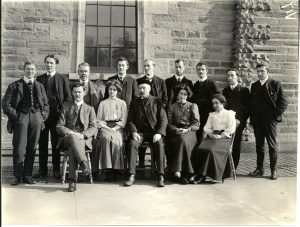
The RBGE Archive contains this photograph of the Advanced Botany Class, Winter 1907-08, University of Edinburgh. Professor Bayley Balfour is seated in the front row centre, and Bertha is on his left [RBGE Archive]
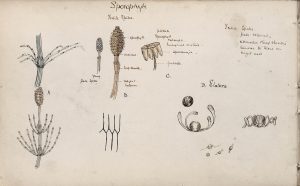
Drawing of ‘Sporophyte’ from Bertha’s Practical Botany Class notebook for the Practical Botany class 1907-08 [RBGE Archive]
From 1908 Bertha worked at RBGE supervised by Bayley Balfour. During that time she undertook the research and experiments that would lead to her obtaining the degree of Doctor of Science (DSc) from the University of Edinburgh in 1913. Bayley Balfour had been the first Edinburgh University student to gain this postgraduate degree. Bertha made Scottish academic history as the first female graduate to attain it.
Bertha’s thesis is on ‘The Theory and Practice of Vegetative Propagation in Flowering Plants.’ A copy of the thesis, with Bertha’s handwritten and signed declaration that the work submitted was done by her, is held in RBGE Archive. The thesis covers dicotyledons, monocotyledons and conifers in turn, and examines stem-cuttings, leaf cuttings and root cuttings as means of vegetative propagation for each group. The thesis is heavily illustrated with diagrams drawn by Bertha, also photographs taken by her and her RBGE colleague Robert Moyes Adam.
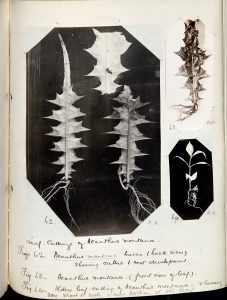
Photographs in Bertha’s D.Sc. showing ‘Leaf cuttings of Acanthus montana.’ [RBGE Archive]
In 1910 Bertha gained the Anderson-Henry Prize. This prize was awarded for the best and approved essay on a botanical subject proposed by the Professor of Botany, the Curator of the Royal Botanic Garden, and the President of the Botanical Society of Edinburgh.
From 1904-1914 Bayley Balfour re-organised the management of the RBGE collections, creating four Assistant posts, with responsibility for the daily running of the Library, the Museum, the Studio, and the Laboratories. In the period 1912-13 Bertha became the first Assistant in Charge of the Laboratories at RBGE.
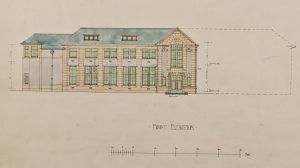
Section of architectural plan of Laboratory Building, RBGE. [RBGE Archive]
X-rays entered Bertha’s life at this point also, as during the First World War she worked at the Second General Military Hospital at Craigleith, Edinburgh, operating X-ray equipment. She later gave illustrated lectures on the topic ‘X-Rays in a Military Hospital.’ In 1919 Bertha was elected a member of the Röntgen Society (founded 1897), which in 1927 amalgamated with the British Institute of Radiology.
Another area that Bertha studied was bio-luminescence. Her earliest published paper on ‘Luminosity in Plants’, was published in the Transactions and Proceedings of the Botanical Society of Edinburgh, volume 23 in 1908. Bertha continued to deliver illustrated lectures on this subject during the 1920s and 1930s. Frustratingly the RBGE Archive contains only part of the manuscript of one of these lectures, donated by Bertha’s daughter.
The Royal Scottish Society of Arts was founded in 1821 (and still active today) to promote and encourage the useful arts in Scotland. The ‘useful arts’ covers all areas of applied science, technology, engineering and manufacture. In 1921 Bertha applied to the Council of the RSSA for a grant from the Keith Bequest to undertake ‘Investigations in the Applications of X-rays to the examination of Materials, with special reference to the radiographic appearances of abnormal conditions in Timber.’
Bertha reviewed the literature and started some experiments but in 1922 submitted a progress report which notes that her research:
‘was interrupted for some time by the transference of attention to the X-Ray examination of coal … This field of investigation also was found to have been almost entirely neglected, and was soon seen to have important and far-reaching possibilities’
Bertha does not appear to have undertaken research after this date, however, she did continue to give illustrated lectures and attend scientific symposia. She also served on the Council of the RSSA for two periods, 1926-1929 and 1938-1943. Bertha died on 23 November 1961.
It is fitting that we celebrate and acknowledge her contribution to RBGE and her practical research across a variety of scientific disciplines through the first decades of women science graduates in Edinburgh.
Written by Graham Hardy, Serials Librarian, RBGE


